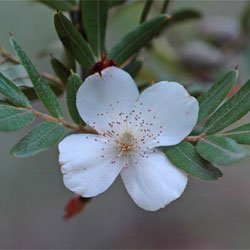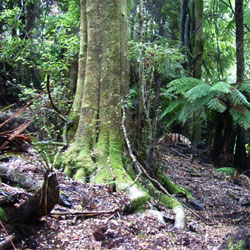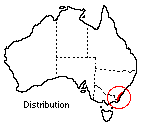Eucryphia moorei
 |
 mature tree in the wild |
Eastern Leatherwood, Plumwood, Pinkwood
Eucryphia moorei is a small handsome tree or tall shrub which occurs naturally in cool temperate rainforest areas on the moist slopes of the coastal ranges in southern New South Wales and Victoria. It is generally found growing in sheltered areas in acid soils rich in organic matter.
The horticultural merit of E. moorei has not been widely recognised. Its slender, upright growth habit makes it ideally suitable for small domestic gardens in the sheltered environment of a courtyard or a small secluded corner. It grows to a height of 6-15 m and looks particularly attractive in Canberra when laden with white blossoms from January to March.
 Eucryphia is the only genus in the family Eucryphiaceae and it occurs only in the southern
hemisphere with two species in Chile and three in Australia. E. moorei is
commonly called Pinkwood, Plumwood or Eastern Leatherwood. The pale, pinkish-brown,
close-grained timber was used by the early settlers for cabinet making and possibly
axe and tool handles. It is related to the Tasmanian E. lucida from which
the highly prized leatherwood honey is sourced.
Eucryphia is the only genus in the family Eucryphiaceae and it occurs only in the southern
hemisphere with two species in Chile and three in Australia. E. moorei is
commonly called Pinkwood, Plumwood or Eastern Leatherwood. The pale, pinkish-brown,
close-grained timber was used by the early settlers for cabinet making and possibly
axe and tool handles. It is related to the Tasmanian E. lucida from which
the highly prized leatherwood honey is sourced.
The bright green leaves which are paler on the undersurface have a tendency to spread horizontally. They are composed of 5 to 13 narrowly oblong leaflets which are 25-50 mm long. The stalked white flowers look somewhat like an open rose and are composed of 4 broad white petals and numerous fluffy stamens. They can be solitary or clustered in the upper leaf axils. The interesting flower buds are enclosed in a cap which is formed by the fusion of the sepals at their tips. The cap falls off when the flower opens. The fruit is a hard egg-shaped capsule 8-16 mm long which splits into segments when ripe to release the small winged seeds. The seed capsules ripen between February and April. They should be placed in a brown paper bag in a warm place until they split open. The capsules themselves are most attractive when they split and can be used in dried flower arrangements.
Eucryphia moorei is best propagated from seed. Small plants should be potted-on into a well-drained organic potting medium until large enough to plant out. For the successful cultivation of this species well composted soil in a sheltered shaded position is essential. The soil should be kept moist during dry periods.
Text by Effie Mullins, ANBG (1989)
Name meaning: Eucryphia mooreiEucryphia - from the Greek eu, well and kryphia, cover, from the cap-like calyx in which the sepals cohere and fall off together; moorei - after Charles Moore (1820 - 1905), a former Director of the Sydney Botanic Garden. |
![An Australian Government Initiative [logo]](/images/austgovt_brown_90px.gif)

